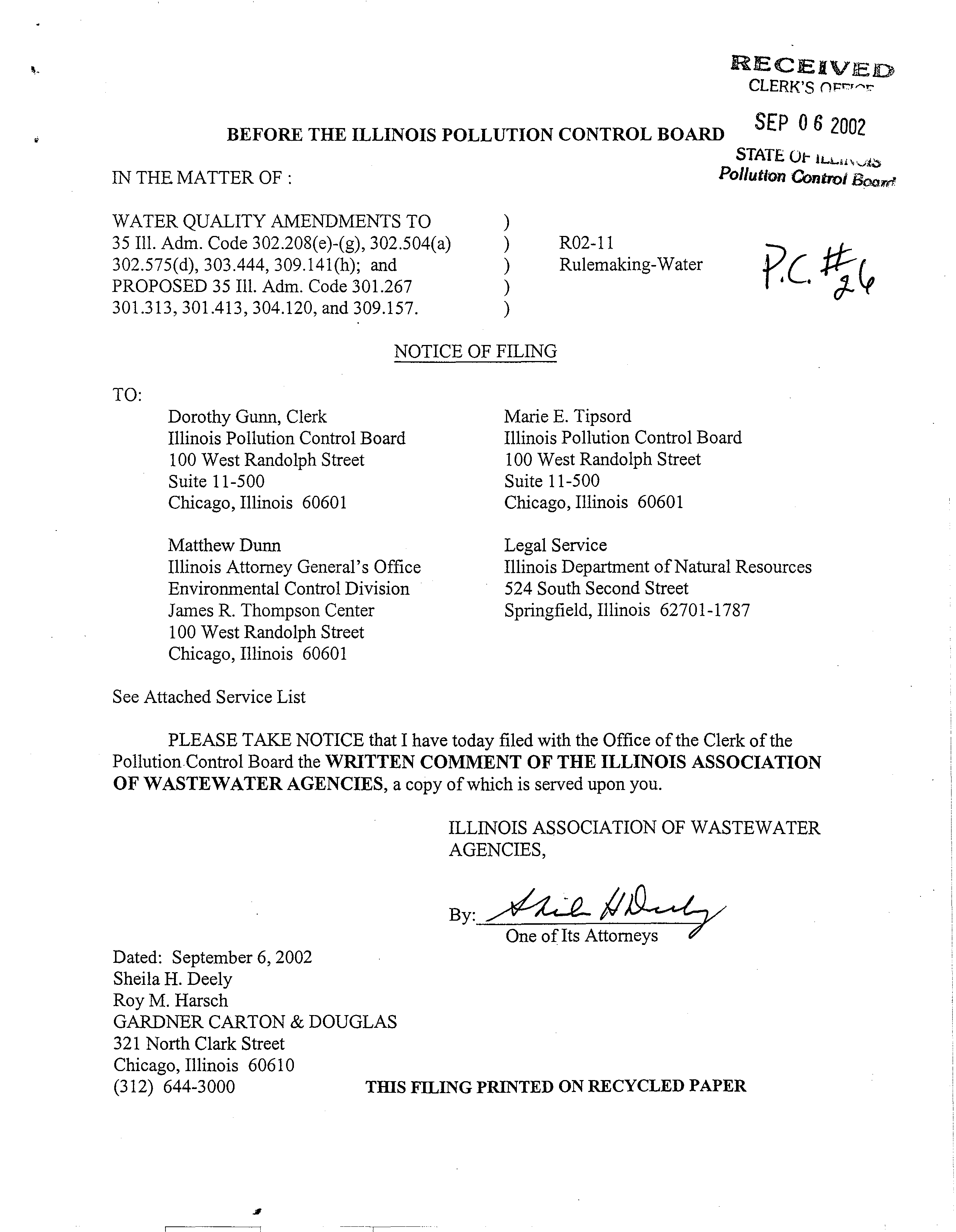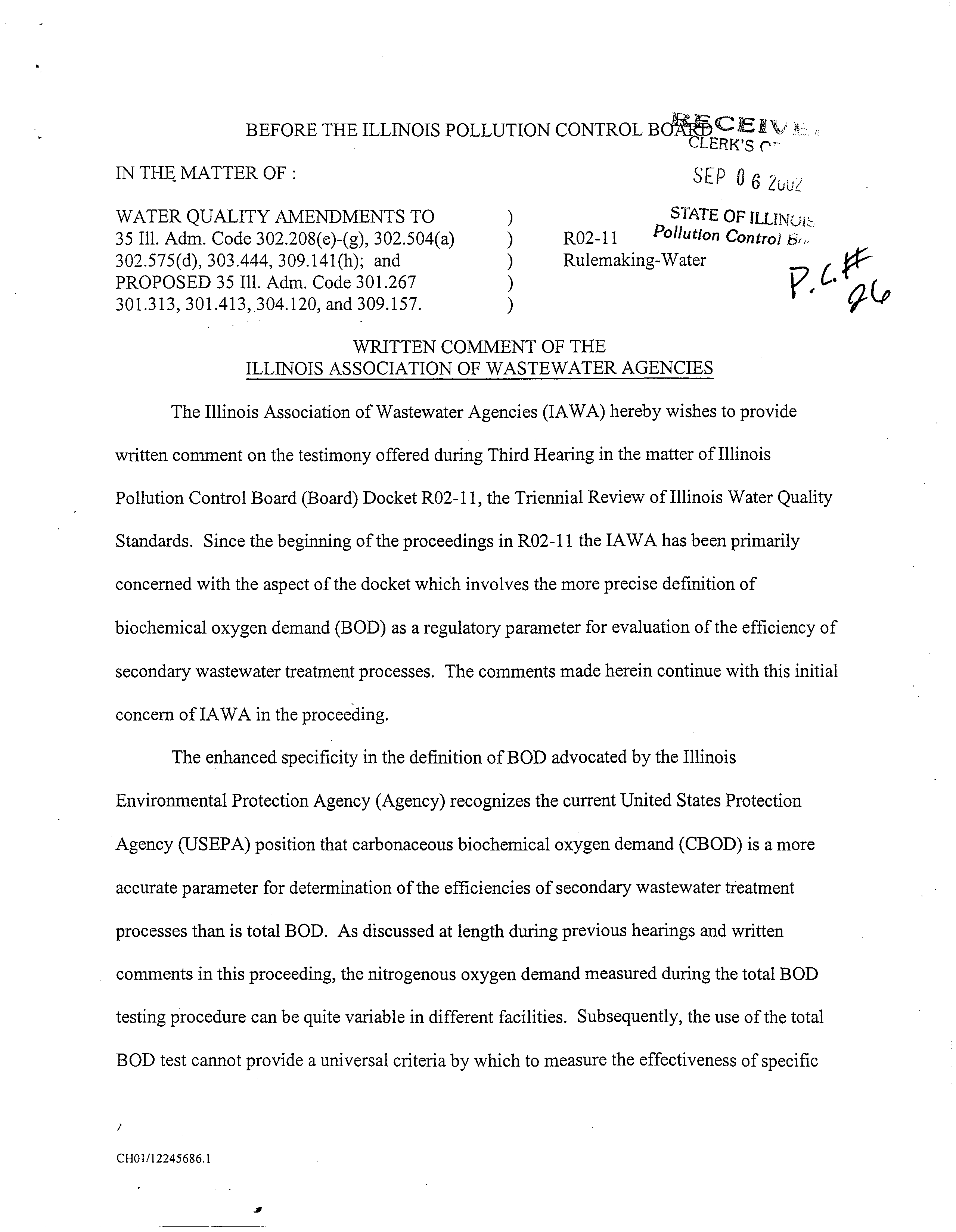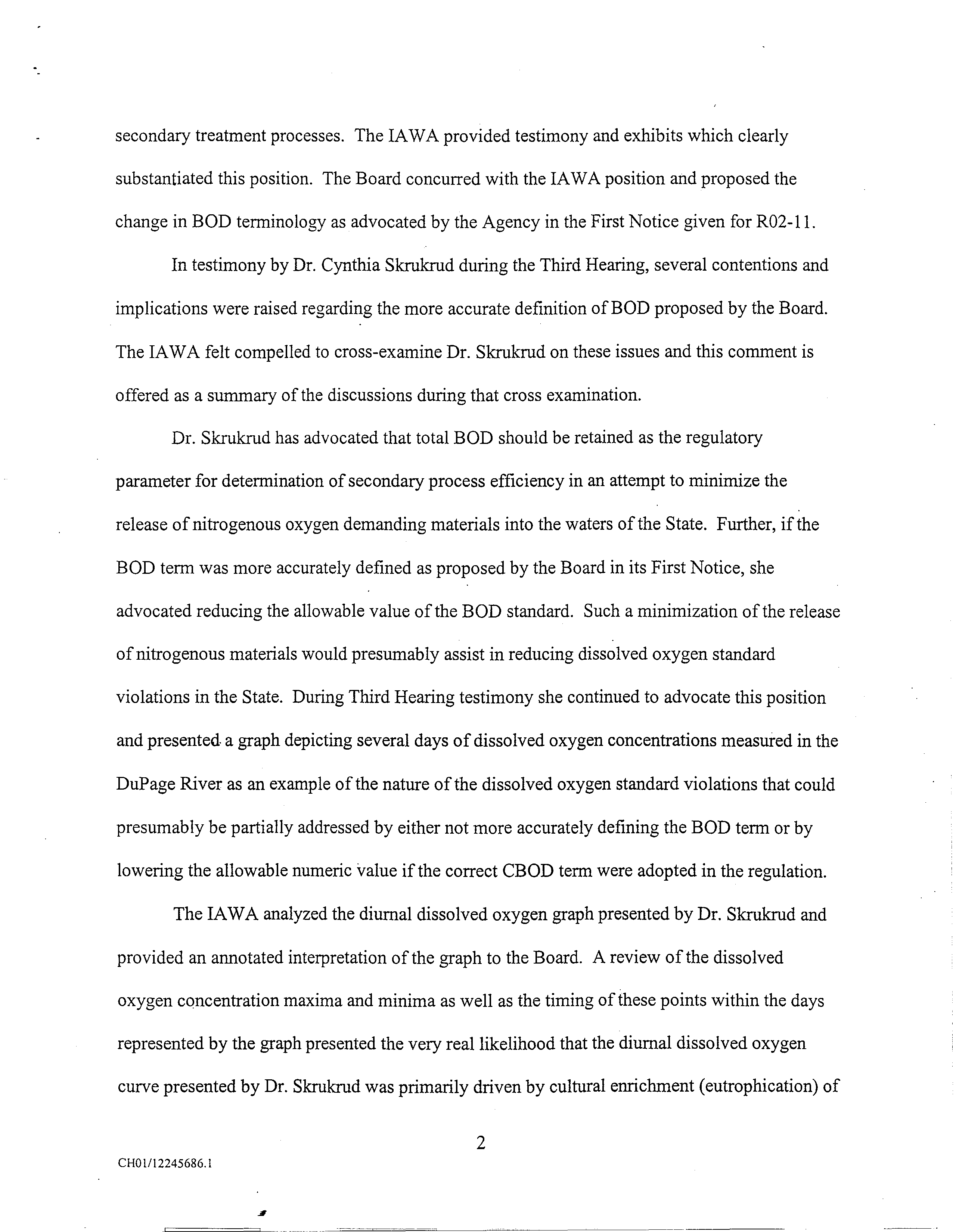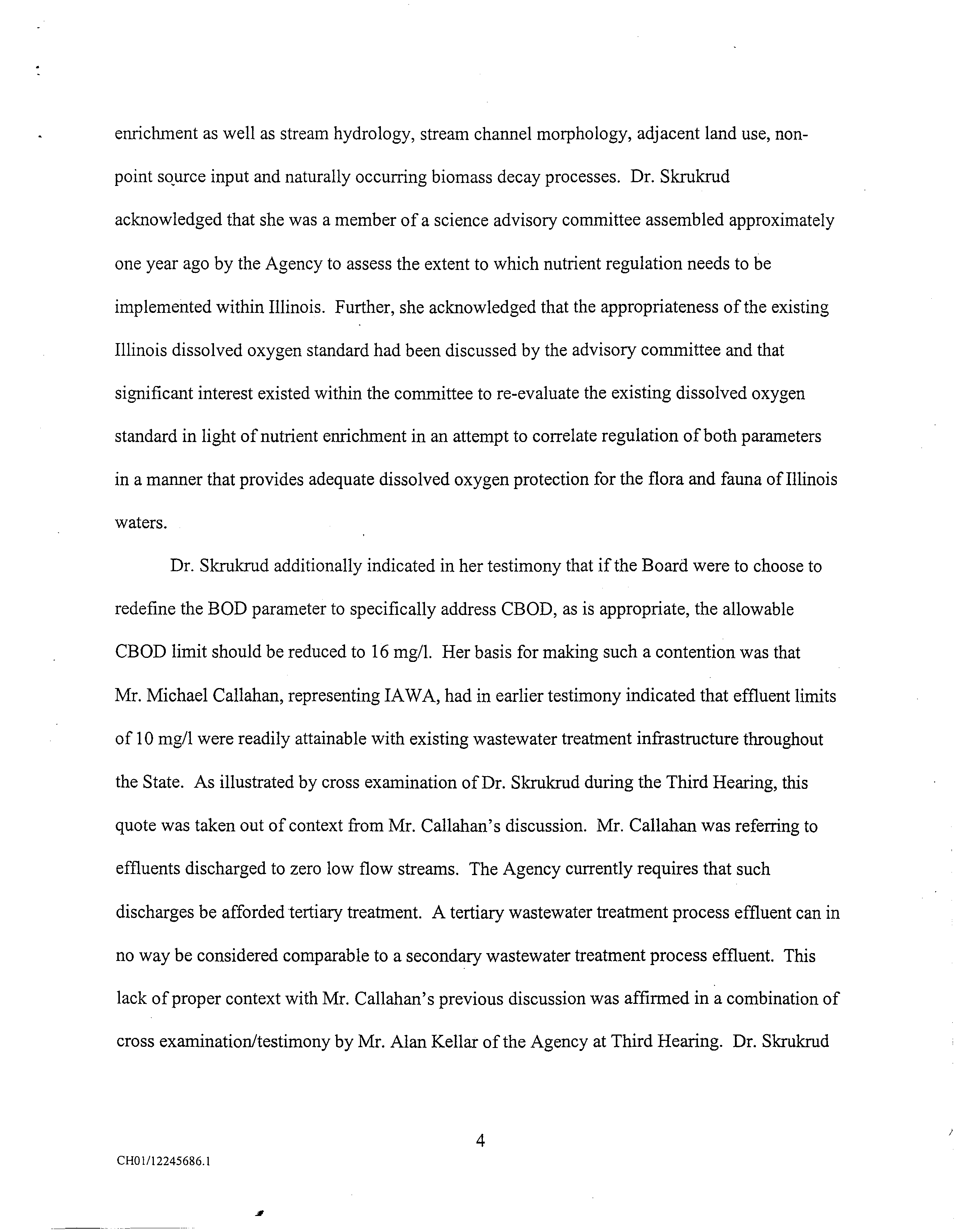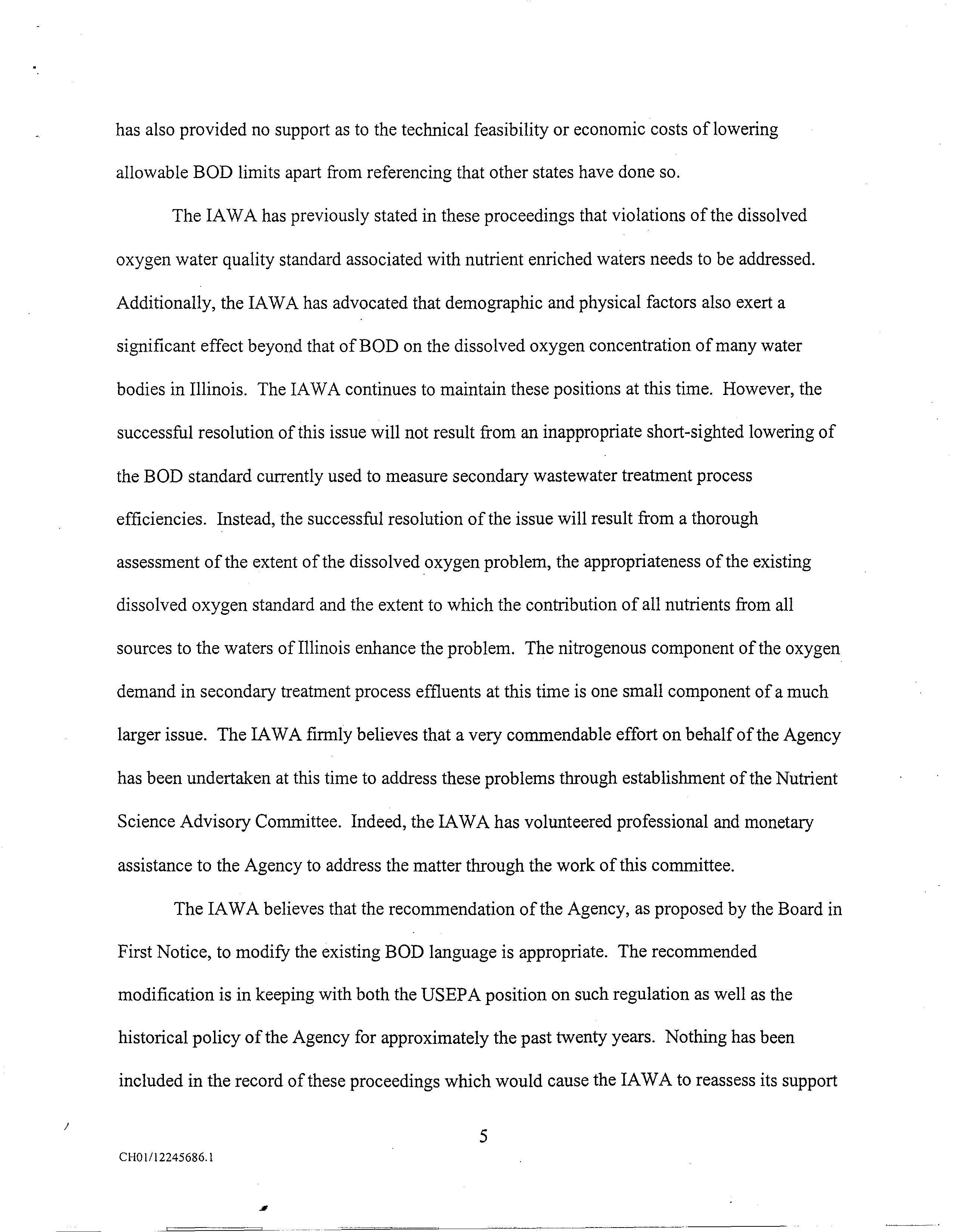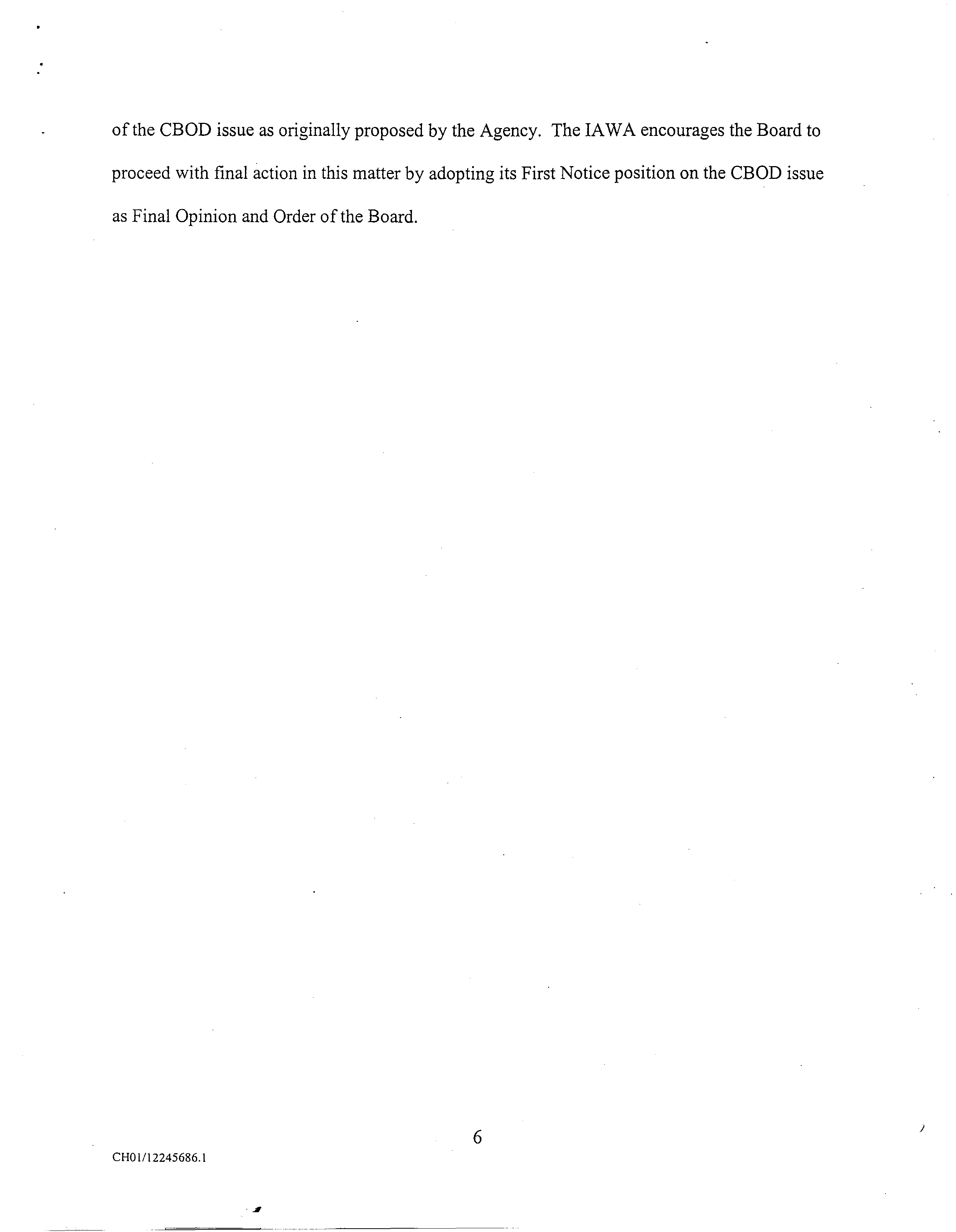BEFORE THE ILLINOIS POLLUTION CONTROL BOARD
IN THE MATTER OF:
WATER QUALITY AMENDMENTS TO
35
Ill. Adm. Code 302.208(e)-(g),
302.504(a)
302.575(d), 303.444, 309.141(h); and
PROPOSED 35 Ill. Adm. Code 301.267
301.313, 301 .413, 304.120, and 309.157.
TO:
Dorothy Gunn, Clerk
Illinois Pollution Control Board
100 West Randolph Street
Suite 11-500
Chicago, Illinois 60601
NOTICE OF FILING
Marie E. Tipsord
Illinois Pollution Control Board
100 West Randolph Street
Suite 11-500
Chicago, Illinois 60601
RECEIVED
CLERK’S
fl~r~-~
SEP 0 6 2002
STATE 01-
~LLu~~
Pollutj~
Controj B~o~
Matthew Dunn
Illinois Attorney General’s Office
Environmental Control Division
James R. Thompson Center
100 West Randolph Street
Chicago, Illinois 60601
See Attached Service List
Legal Service
Illinois Department ofNatural Resources
524 South Second Street
Springfield, Illinois 62701-1787
PLEASE TAKE NOTICE that I have today filedwith the Office ofthe Clerk ofthe
PollutjonControl Board the WRITTEN
COMMENT OF THE ILLINOIS ASSOCIATION
OF WASTEWATER AGENCIES,
a copy ofwhich is served upon you.
ILLINOIS ASSOCIATION OF WASTEWATER
AGENCIES,
Dated: September 6, 2002
Sheila H. Deely
Roy M. Harsch
GARDNER CARTON & DOUGLAS
321 North Clark Street
Chicago, Illinois 60610
(312) 644-3000
By:
~
One ofIts Attorneys
)
)
R02-11
)
Rulemaking-Water
fi’C.
)
I
)
THIS FILING PRINTED ON RECYCLED PAPER
BEFORE THE ILLINOIS POLLUTION CONTROL Bc~CEF~v~
CLERK’S (‘~
IN THE MATTER OF:
SEP
(1
-
WATER QUALITY AMENDMENTS TO
)
SThTE OF ILLJNUk
35 Ill. Adm. Code 302.208(e)-(g), 302.504(a)
)
R02-l 1
~
Control.
302.575(d), 303.444, 309.141(h); and
)
Rulemaking-Water
PROPOSED 35 Iii. Adm. Code 301.267
)
301.313, 301.413, 304.120, and
309.157.
)
WRITTEN COMMENT OF THE
ILLINOIS ASSOCIATION OF WASTEWATER AGENCIES
The Illinois Association ofWastewater Agencies (IAWA) hereby wishes to provide
written comment on the testimony offered during Third Hearing in the matter ofIllinois
Pollution Control Board (Board) Docket R02-1 1, the Triennial Review of Illinois Water Quality
Standards. Since the beginning of the proceedings in R02-1 1 the IAWA has been primarily
concerned with the aspect ofthe docket which involves the more precise definition of
biochemical oxygen demand (BOD) as a regulatory parameter for evaluation of the efficiency of
secondary wastewater treatment processes. The comments made herein continue with this initial
concern ofIAWA in the proceeding.
The enhanced specificity in the definition ofBOD advocated by the Illinois
Environmental Protection Agency (Agency) recognizes the current United States Protection
Agency (USEPA) position that carbonaceous biochemical oxygen demand (CBOD) is a more
accurate parameter for determination ofthe efficiencies ofsecondary wastewater treatment
processes than is total BOD. As discussed at length during previous hearings and written
comments in this proceeding, the nitrogenous oxygen demand measured during the total BOD
testing procedure can be quite variable in different facilities. Subsequently, the use of the total
BOD test cannot provide a universal criteria by which to measure the effectiveness of specific
CHOI/12245686.1
-F
secondary treatment processes. The IAWA provided testimony and exhibits which clearly
substantiated this position. The Board concurred with the IAWA position and proposed the
change in BOD terminology as advocated by the Agency in the First Notice given for R02- 11.
In testimony by Dr. Cynthia Skrukrud during the Third Hearing, several contentions and
implications were raised regarding the more accurate definition of BOD proposed by the Board.
The IAWA felt compelled to cross-examine Dr. Skrukrud on these issues and this comment is
offered as a summary of the discussions during that cross examination.
Dr. Skrukrud has advocated that total BOD should be retained as the regulatory
parameterfor determination ofsecondary process efficiency in an attempt to minimize the
release ofnitrogenous oxygen demanding materials into the waters of the State. Further, if the
BOD term was more accurately defined as proposed by the Board in its First Notice, she
advocated reducing the allowable value ofthe BOD standard. Such
a
minimization ofthe release
of nitrogenous materials would presumably assist in reducing dissolved oxygen standard
violations in the State. During Third Hearing testimony she continued to advocate this position
and presented a graph depicting several days ofdissolved oxygen concentrations measured in the
DuPage River as an example ofthe nature ofthe dissolved oxygen standard violations that could
presumably be partially addressed by either not more accurately defining the BOD term or by
lowering the allowable numeric value if the correct CBOD term were adopted in the regulation.
The JAWA analyzedthe diurnal dissolved oxygen graph presented by Dr. Skrukrud and
provided an annotated interpretation of the graph to the Board. A review ofthe dissolved
oxygen concentration maxima and minima as well as the timing ofthese points within the days
represented by the graph presented the very real likelihood that the diurnal dissolved oxygen
curve presented by Dr. Skrukrud was primarily driven by cultural enrichment (eutrophication) of
2
CHOI/12245686. 1
the DuPage River. Cultural enrichment is driven by nutrient release, specifically nitrogen and
phosphQrous, into the receiving water in concentrations that effectively result in an “over
fertilization” ofthe water body. This “over fertilization” stimulates algal growth which, during
the day, can provide supersaturated dissolved oxygen concentrations in response to
photosynthesis. Such supersaturated dissolved oxygen concentrations were indicated on
Dr. Skrukrud’s graph. The timing of the appearance of these supersaturated conditions, late
afternoon after the daily period of maximum solar irradiation, is
a
further indication ofnutrient
enrichment.
Low dissolved oxygen concentrations can also develop from nutrient enrichment because
ofthe increased cellular respiration resulting from the artificially large algal biomass maintained
by the “over fertilization.” During the night, when the algae are not photosynthesizing, the
ambient dissolved oxygen replenishment mechanisms of
a
water body are inadequate to meet the
respiration demands of the enhanced algal biomass. Consequently, undesirably low dissolved
oxygen concentrations result. The timing of the dissolved oxygen minima indicated on the graph
provided by Dr. Skrukrud also corresponds to the diurnal schedule associated with nutrient
enrichment. Specifically, the minima were depicted as occurring at approximately 8:00 AM,
after the night time absence of sunlight and subsequent lack ofphotosynthetic activity. These
minima were the dissolved oxygen water quality standard violations to which Dr. Skrukrud was
alluding as justification for not proceeding with the more precise definition ofregulated BOD as
the Board proposed in its First Notice.
Under cross-examination, Dr. Skrukrud admitted that the conditions depicted by the
graph she supplied were indicative ofnutrient enrichment. She further agreed that state-wide
violations ofthe dissolved oxygen water quality standard could be attributed to such nutrient
3
CHOI/12245686J
enrichment as well as stream hydrology, stream channel morphology, adjacent land use, non-
point source input and naturally occurring biomass decay processes. Dr. Skrukrud
acknowledged that she was a member ofa science advisory committee assembled approximately
one year ago by the Agency to assess the extent to which nutrient regulation needs to be
implemented within Illinois. Further, she acknowledged that the appropriateness ofthe existing
Illinois dissolved oxygen standard had been discussed by the advisory committee and that
significant interest existed within the committee to re-evaluate the existing dissolved oxygen
standard in light ofnutrient enrichment in an attempt to correlate regulation of both parameters
in
a
manner that provides adequate dissolved oxygen protection forthe flora and fauna ofIllinois
waters.
-
Dr. Skrukrud additionally indicated in her testimony that if the Board were to choose to
redefine the BUD parameter to specifically address CBOD, as is appropriate, the allowable
CBOD limit should be reduced to 16 mg/l. Her basis for making such a contention was that
Mr. Michael Callahan, representing IAWA, had in earlier testimony indicated that effluent limits
of 10 mg/l were readily attainable with existing wastewater treatment infrastructure throughout
the State. As illustrated by cross examination ofDr. Skrukrud during the Third Hearing, this
quote was taken out ofcontext from Mr. Callahan’s discussion. Mr. Callahan was referring to
effluents discharged to zero low flow streams. The Agency currently requires that such
discharges be afforded tertiary treatment. A tertiary wastewater treatment process effluent can in
no way be considered comparable to a secondary wastewater treatment process effluent. This
lack ofproper context with Mr. Callahan’s previous discussion was affirmed in a combination of
cross examinationltestimony by Mr. Alan Kellar of the Agency at Third Hearing. Dr. Skrukrud
4
CHOI/12245686.1
has also provided no support as to the technical feasibility or economic costs oflowering
allowable BUD limits apart from referencing that other states have done so.
The IAWA has previously stated in these proceedings that violations of the dissolved
oxygen water quality standard associated with nutrient enriched waters needs to be addressed.
Additionally, the IAWA has advocated that demographic and physical factors also exert a
significant effect beyond that of BOD on the dissolved oxygen concentration ofmany water
bodies in Illinois. The IAWA continues to maintain these positions at this time. However, the
successful resolution of this issue will not result from an inappropriate short-sighted lowering of
the BUD standard currently used to measure secondary wastewater treatment process
efficiencies. Instead, the successful resolution ofthe issue will result from a thorough
assessment ofthe extent ofthe dissolved oxygen problem, the appropriateness ofthe existing
dissolved oxygen standard and the extent to which the contribution ofall nutrients from all
sources to the waters ofIllinois enhance the problem. The nitrogenous component of the oxygen
demand in secondary treatment process effluents at this time is one small component of a much
larger issue. The IAWA firmly believes that a very commendable effort on behalf ofthe Agency
has been undertaken at this time to address these problems through establishment ofthe Nutrient
Science Advisory Committee. Indeed, the IAWA has volunteered professional and monetary
assistance to the Agency to address the matter through the work ofthis committee.
The IAWA believes that the recommendation ofthe Agency, as proposed by the Board in
First Notice, to modify the existing BOD language is appropriate. The recommended
modification is in keeping with both the USEPA position on such regulation as well as the
historical policy ofthe Agency for approximately the past twenty years. Nothing has been
included in the record of these proceedings which would cause the IAWA to reassess its support
5
C1-1O1/12245686. 1
ofthe CBOD issue as originally proposed by the Agency. The IAWA encourages the Board to
proceed with final action in this matter by adopting its First Notice position on the CBOD issue
as Final Opinion and Order of the Board.
6
CHOI/12245686.1
CERTIFICATE OF SERVICE
The undersigned certifies that
a
copy ofthe foregoing
WRITTEN COMMENT OF THE
ILLINOIS ASSOCIATION OF WASTEWATER AGENCIES
was filed by hand delivery with
the Clerk ofthe Illinois Pollution Control Board and served upon the parties to whom said Notice is
directed by first class mail, postage prepaid, by depositing in the U.S. Mail at 321 North Clark Street,
Chicago, Illinois on Friday, September 6, 2002.
CHO2/221 73413.1
.1
